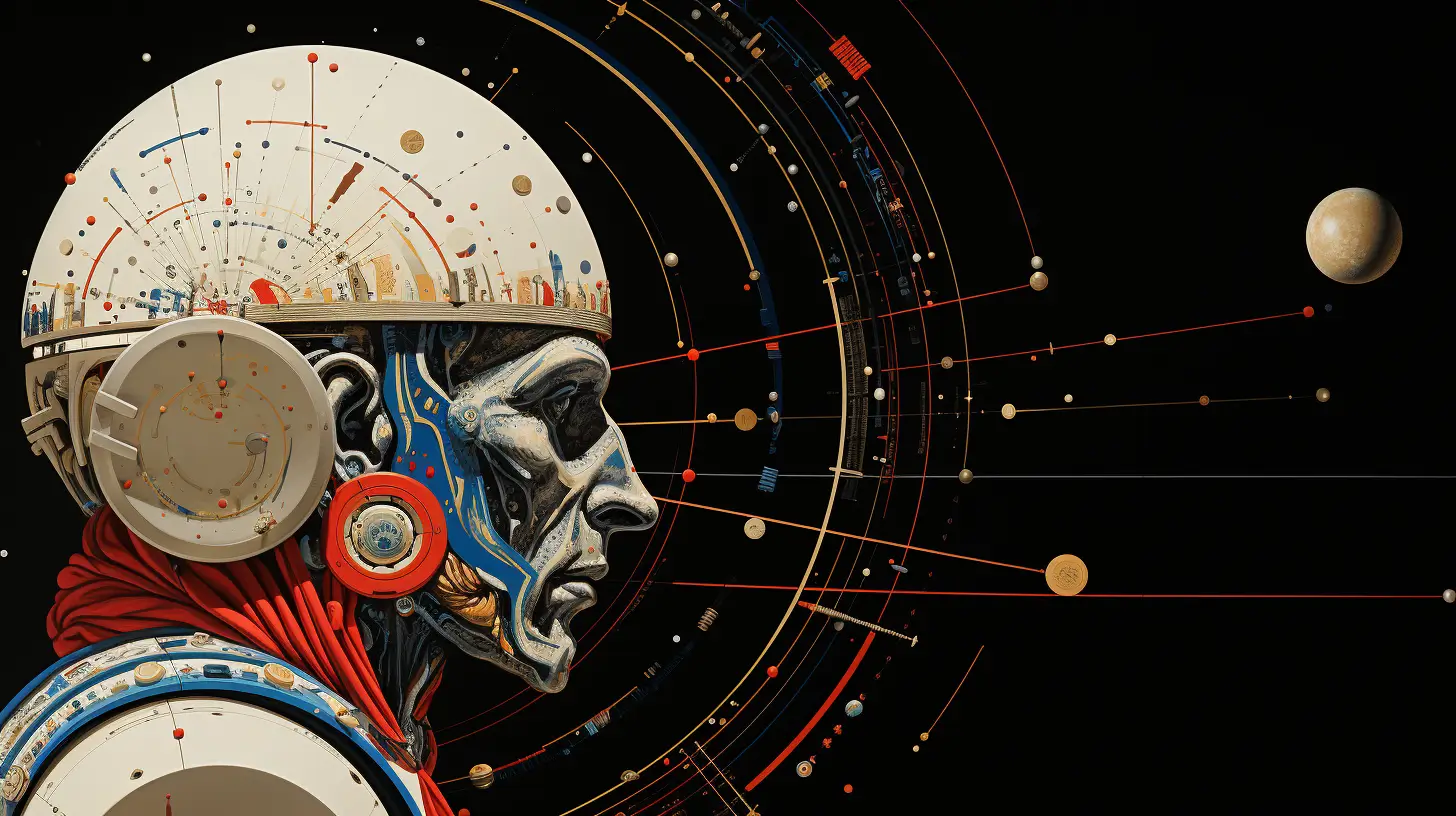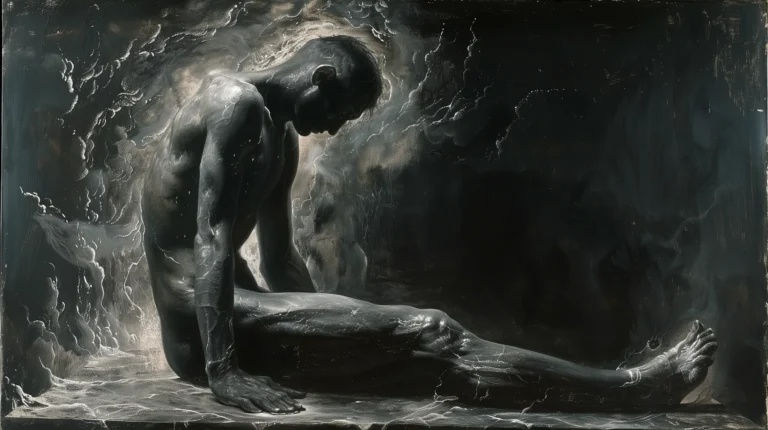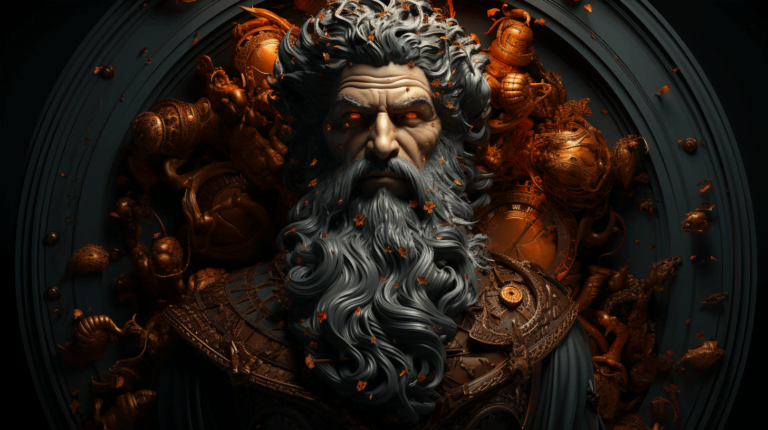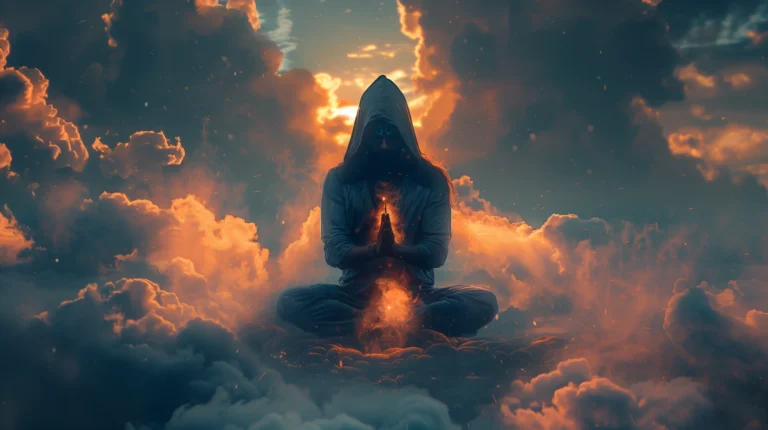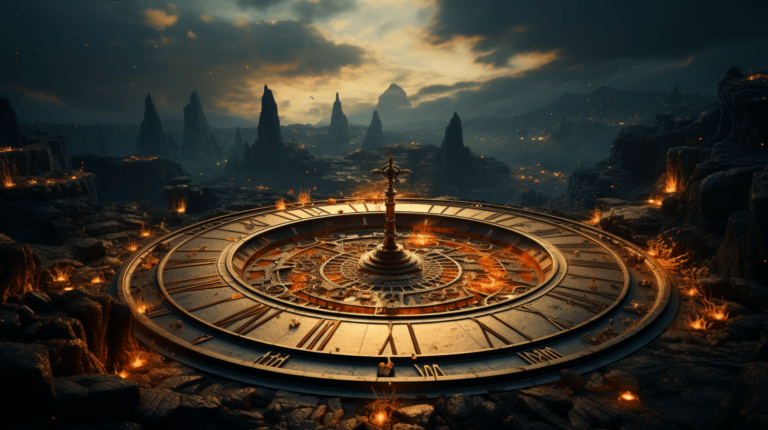From Binary Thought to Boundless Consciousness
Table of Contents
- Introduction
- Historical Perspective on Dualism
- The Spectrum of Dualities
- The Challenge of Bridging Dualities
- Beyond the Dichotomy
- The Divine Outcome
- Practical Implications and Applications
- Barriers to Embracing Union
- Conclusion
Introduction
The concept of duality is deeply woven into the fabric of existence, painting the universe with contrasting shades that define and balance each other. It is a philosophical theme that has been pondered, celebrated, and sometimes even feared across cultures, disciplines, and eras. But what exactly is duality, and why is the notion of its union so captivating?
Definition of Duality
Duality, at its core, represents the existence of two fundamental principles, forces, or aspects in contrast yet intrinsically linked. It’s the dance of opposites, where each half defines the other: light and dark, positive and negative, matter and antimatter, conscious and subconscious. These aren’t merely opposing forces, but rather complementary components of a greater whole. They are the yin and yang of existence, embodying both conflict and harmony, serving as the juxtaposed threads that weave the tapestry of reality.
“Out of chaos, find simplicity. From discord, find harmony.” – Bruce Lee
Bruce Lee’s insight into the essence of duality highlights the inherent balance and interdependence between opposing forces. This quote encapsulates the chapter’s exploration of duality, not as a battleground of opposites but as a dynamic interplay that fosters the emergence of complexity and unity from the heart of contrast.
Purpose of the Book
This small book seeks to delve into the profound realm of dualities, not just as opposing ends of a spectrum but as potential partners in creating something transcendent. We will explore the spectrum of dualities, understanding them not as stark opposites, but as interconnected points on a continuum. The central theme is the potential union of these dual forces, the alchemy of merging them to birth something unique, something divine. Beyond a mere exploration of philosophical concepts, this piece aims to challenge the prevalent dichotomous thinking and advocate for a paradigm shift towards embracing the union of opposites. In doing so, we aspire to illuminate the pathways to a deeper, more holistic understanding of existence, one that transcends binary confines and celebrates the divine synthesis of dualities.
“The goal of life is to make your heartbeat match the beat of the universe, to match your nature with Nature.” – Joseph Campbell
Joseph Campbell’s reflection on life’s purpose beautifully aligns with the book’s aim to transcend binary thought. His words inspire readers to see the union of dualities not as an end but as a means to align more closely with the universal flow, suggesting that in the synthesis of opposites, we find a deeper resonance with the cosmos itself.
Historical Perspective on Dualism
Across the vast expanse of human history, societies have sought to make sense of the world and their place in it through philosophical inquiries. One recurring theme that has stood the test of time, found in both Eastern and Western philosophies, is the concept of duality. The contrasting forces, whether external or internal, physical or metaphysical, have been central to many philosophical paradigms.
Ancient Philosophies and Dualities
Yin and Yang: Central to Chinese philosophy, the concept of Yin and Yang represents the interdependency of opposites. Originating from Taoism, it illustrates how contrary forces are not only interconnected but interdependent in the natural world. Yin, characterized as shadow, is the passive, dark, feminine principle, while Yang, its counterpart, is the active, bright, masculine force. Together, they represent the cyclical nature of life and the balance necessary for harmony.
“Nature does not hurry, yet everything is accomplished.” – Lao Tzu
This quote from Lao Tzu, a seminal figure in Taoist philosophy, encapsulates the essence of Yin and Yang. It suggests a profound acceptance of the natural order, where the interplay of opposites leads to harmony and completion. This wisdom invites readers to reflect on the cyclic nature of existence, recognizing the balance and unity inherent in the world around us.
Zoroastrian Dualism: Rooted in ancient Persia, Zoroastrianism presents a dualistic cosmology of Ahura Mazda, the supreme god of creation, and Angra Mainyu, the destructive spirit. This religious philosophy articulates the battle between good and evil, where both forces are in perpetual opposition. Yet, it also underlines the eventual triumph of good, portraying a hopeful vision of the future.
“Good and evil, reward and punishment, are the only motives to a rational creature.” – John Locke
John Locke’s perspective, though not directly from Zoroastrianism, parallels its dualistic view of the universe. Locke’s words prompt readers to consider the moral dimensions of dualism, where the struggle between good and evil shapes not only cosmic order but also human ethics and destiny.
Platonic Forms and Material World
Plato, one of the pillars of Western philosophy, introduced a profound form of dualism in his theory of forms. He posited that our tangible world, filled with changeable and imperfect entities, is just a shadow or reflection of the eternal and unchanging world of forms (or ideas). These forms, according to Plato, are the true reality, the perfect archetypes of the things we see in our fluctuating world.
This dualism between the realm of perfect forms and the imperfect material world underscored the pursuit of knowledge. For Plato, true understanding came from grasping these eternal forms, elevating the mind beyond the transient and towards the eternal. Such a perspective not only influenced the subsequent philosophical thoughts but also seeded the roots for debates on materialism versus idealism.
“The measure of a man is what he does with power.” – Plato
Plato’s contemplation on power and action mirrors his dualistic view of the world of forms versus the material realm. This quote challenges readers to think about the application of Platonic dualism in personal growth and understanding, encouraging a deeper inquiry into how ideals can shape reality.
Both the East and West, through their unique philosophical lenses, have grappled with the concept of dualities. Whether it’s the harmonious interplay of Yin and Yang or the lofty ideals of Platonic forms contrasted with the tangible world, dualism remains a compelling narrative, urging us to explore the tensions and harmonies between opposing forces.
The Spectrum of Dualities
Human comprehension often relies on the categorization of experiences, emotions, and entities into binaries. However, upon deeper reflection, it becomes evident that these categories are not strictly black or white. Rather, they exist on a continuum, with many shades in between.
Understanding Dualities as Polarities on a Spectrum
To truly grasp the depth and breadth of dualities, one must envision them not as isolated points, but as endpoints on a spectrum. For instance, hot and cold are not independent entities but degrees of temperature. Similarly, love and hate might be viewed as intense emotional states on opposite ends, but there exists a vast range of feelings in between.
This perspective shift from binary to spectrum is revolutionary. It allows for a more nuanced understanding of the world and our experiences within it. No longer are things merely good or bad, right or wrong; they can be somewhere in between, influenced by context, perception, and individual interpretation.
“The pendulum of the mind oscillates between sense and nonsense, not between right and wrong.” – Carl Jung
Carl Jung’s insight into the workings of the mind underscores the concept of dualities as a spectrum rather than a binary. His observation invites readers to consider how our perceptions and judgments swing within a vast range of possibilities, challenging the simplicity of black-and-white thinking. This perspective encourages a deeper appreciation for the complexity of experiences and the nuanced shades between traditional dualities.
The Interplay of Opposites: Where Light Meets Dark
Just as dusk is the mesmerizing meeting of day and night, the interplay between opposing forces creates some of life’s most profound moments. It’s in this gray area, this blending of light and dark, that true magic often happens.
Consider the twilight, neither wholly day nor completely night, but a time of transition, reflection, and beauty. It embodies the union of opposites and serves as a reminder of the fluidity of existence. Similarly, the balance between strength and vulnerability, certainty and doubt, or joy and sorrow, creates the multidimensional fabric of human experience.
By focusing solely on the extremes, we risk missing the intricate dance of dualities, where they come together, clash, or coexist. It’s crucial to recognize these moments, for they not only offer insights into the nature of existence but also pave the way for growth, innovation, and evolution.
“There is a crack in everything. That’s how the light gets in.” – Leonard Cohen
Leonard Cohen’s poetic reflection captures the essence of finding beauty and hope in the blending of opposites. This quote illuminates the chapter’s exploration of the gray areas in life, where contradictions coalesce to reveal deeper truths and unexpected insights. Cohen’s words resonate with the idea that it’s within the interstices of dualities—where light meets dark—that we often discover the most profound aspects of human experience.
In this exploration, we beckon readers to shift from a dichotomous mindset to one that appreciates the spectrum of dualities. By doing so, we open ourselves to a richer, more interconnected understanding of the world around us, embracing the shades where light meets dark.
The Challenge of Bridging Dualities
The human psyche is a complex tapestry woven with threads of emotions, beliefs, experiences, and perceptions. When confronted with dualities, it often finds itself tugged in opposing directions, leading to internal conflicts and challenges. Bridging these dualities is no simple task, as it requires a deep understanding and a willingness to navigate the turbulent waters of cognitive and psychological tensions.
Cognitive Dissonance and Dichotomous Thinking
Cognitive dissonance, a term coined by social psychologist Leon Festinger, refers to the mental discomfort experienced when one holds contradictory beliefs, values, or attitudes. Dichotomous thinking, the tendency to view situations, people, or events in binary terms (such as good/bad, right/wrong), exacerbates this discomfort. By placing experiences into rigid categories, we limit our ability to see the nuances and complexities inherent in situations.
For instance, when faced with a moral dilemma, one might struggle to reconcile personal beliefs with societal norms. This tension can lead to confusion, guilt, and even behavioral changes as the individual seeks to minimize the dissonance. The reliance on dichotomous thinking, in such scenarios, acts as a barrier to synthesizing opposing viewpoints or finding a middle ground.
“The test of a first-rate intelligence is the ability to hold two opposed ideas in mind at the same time and still retain the ability to function.” – F. Scott Fitzgerald
Fitzgerald’s observation speaks directly to the heart of cognitive dissonance and dichotomous thinking. It suggests that the mark of profound understanding and intelligence is not in choosing one idea over another but in the capacity to embrace the complexity of holding contradictory thoughts concurrently. This insight encourages readers to see beyond binary classifications and to appreciate the mental flexibility required to navigate the nuances of life’s dualities.
Holding Tensions Between Opposites
The challenge isn’t just cognitive; it’s deeply psychological. Embracing dualities demands a mental resilience to hold tensions between opposing forces without succumbing to the pressure to choose a side. It’s like walking a tightrope, maintaining balance amidst the pull of contradicting emotions, beliefs, and perceptions.
This strain can manifest in various ways. An artist might grapple with the duality of creation and destruction, a therapist might wrestle with detachment and empathy, and an individual might battle the duality of societal expectations versus personal aspirations. The psychological weariness from holding these tensions can sometimes lead to stress, anxiety, and even existential crises.
“One does not become enlightened by imagining figures of light, but by making the darkness conscious.” – Carl Jung
Carl Jung’s wisdom illuminates the psychological journey of bridging dualities. It points to the necessity of confronting and integrating the shadow aspects of our psyche to achieve a balanced and enlightened state. Jung’s perspective offers a path forward for readers grappling with the inner tensions between opposites, highlighting the transformative power of acknowledging and working through the darker, more complex facets of our nature.
Bridging the vast chasm of dualities is an endeavor fraught with challenges, both cognitive and psychological. Yet, it’s this very journey, with its trials and tribulations, that holds the promise of a deeper, more holistic understanding of oneself and the world. Recognizing and acknowledging these challenges is the first step towards transcending them.
Beyond the Dichotomy
The grand tapestry of human thought, spanning across epochs and cultures, has been consistently marked by efforts to reconcile and merge dualities. This endeavor of synthesis is not merely an intellectual exercise but a deeply spiritual and transformative journey that pushes the boundaries of conventional wisdom and nurtures growth.
Historical and Cultural Examples of Synthesis
The Middle Way in Buddhism: Siddhartha Gautama, who later became the Buddha, explored both the extremes of asceticism and indulgence in his quest for enlightenment. However, he realized that neither extreme brought true understanding or liberation. This led him to advocate the Middle Way, a path of moderation between self-denial and self-indulgence. By doing so, he presented a harmonious approach, recognizing the interconnectedness of all things and emphasizing balance and equanimity.
“There is a middle way between the extremes of indulgence and self-denial, free from sorrow and suffering. This is the way to peace and liberation in this very life.” – Buddha
Buddha’s teachings, offers a clearer depiction of the Middle Way. It suggests a balanced approach to life, avoiding the extremes of sensory indulgence and severe asceticism. This path, according to the Buddha, is the route to enlightenment, providing a practical framework for spiritual development.
Alchemy in Medieval Europe: Alchemy, often considered the precursor to modern chemistry, was also a spiritual and philosophical endeavor. Alchemists believed in the union of opposites, symbolized by the conjoining of the Sun (masculine, gold) and the Moon (feminine, silver). This synthesis was seen as a process of perfecting substances, and by extension, the soul. The Magnum Opus, or the Great Work of alchemy, represented the transformative process of turning base metals into gold, symbolizing spiritual refinement and the merging of dual forces.
“In truth, without deceit, certain, and most veritable.” – The Emerald Tablet
Though this phrase from The Emerald Tablet, a foundational text of alchemical thought, might seem cryptic, it speaks to the alchemical pursuit of unity and transformation. It suggests a process of uncovering deep truths through the synthesis of opposites, resonating with the journey towards achieving a spiritual and psychological wholeness.
The Process of Transcendence
Transcending dichotomous thinking requires an inner shift, a metamorphosis of the mind and spirit. It’s about expanding one’s consciousness to embrace the vast spectrum of experiences without being tethered to rigid categories.
Awareness: Recognizing the limitations of binary thinking and developing an openness to explore the spaces in between.
Acceptance: Embracing the ambiguities, uncertainties, and paradoxes that arise when merging dualities.
Integration: Actively seeking to understand and incorporate opposing viewpoints, experiences, or emotions into one’s worldview.
Transformation: As one starts to integrate dualities, there’s a profound inner change. The boundaries that once seemed insurmountable begin to blur, giving rise to a more holistic, interconnected perspective on life.
Moving beyond the dichotomy is akin to evolving from a two-dimensional plane to a three-dimensional space. It’s a journey that enriches the soul, broadens the mind, and offers a panoramic view of existence, where every duality is but a dance of energies, constantly converging and diverging in the cosmic play of life.
“The bird flies with its two wings: man ascends to the truth through two wings of effort and grace.” – Rumi
Rumi’s metaphor of a bird using both wings to fly serves as a beautiful illustration of transcendence. It emphasizes the balance between personal effort and divine grace in the ascent towards truth, mirroring the synthesis of dualities. This quote encourages readers to embrace the complexity of their nature and the world, suggesting that true understanding comes from the harmonious integration of divergent forces.
The Divine Outcome
The dance of dualities, when orchestrated with conscious intent and understanding, can culminate in a transcendent experience that redefines our perception of existence. It is akin to the convergence of rivers into an ocean, where individual identities meld into a vast, boundless entity, echoing with the rhythms of the cosmos.
Creation of New Paradigms and Perspectives
When the lines dividing dualities begin to blur, a transformational shift occurs, giving birth to paradigms that were previously unfathomable. The union of dual forces fosters creativity and innovation. Much like the blending of colors creates a new hue, the synthesis of opposing ideas, beliefs, or energies results in novel perspectives.
Art, for instance, often thrives at the intersection of contrasts. The amalgamation of pain and joy, chaos and order, or tradition and rebellion can give rise to masterpieces that resonate with the human spirit. Similarly, in science, the merging of disciplines or theories can lead to groundbreaking discoveries that reshape our understanding of the universe.
“Without contraries is no progression.” – William Blake
William Blake’s assertion captures the essence of creating new paradigms through the synthesis of dualities. It suggests that the interplay of opposites is not only natural but necessary for growth and innovation. This perspective invites readers to view the blending of dualities not as a compromise but as an opportunity for evolution, where the fusion of contrasting elements leads to the emergence of new understandings and realities.
Enlightenment, Wholeness, and the Cosmic Dance
Enlightenment is often portrayed as the pinnacle of spiritual evolution, a state of heightened awareness where one transcends the confines of the ego and perceives the interconnectedness of all existence. At the heart of this experience lies the union of dualities, where the self and the cosmos, the finite and the infinite, the transient and the eternal become one.
This sense of wholeness is not a mere philosophical concept but a profound realization that life, in all its dichotomies, is a cosmic dance. The ebbs and flows, the highs and lows, the joys and sorrows – they are all part of this intricate choreography. And when one truly embraces this dance, there emerges a harmony, a rhythm that aligns with the universe.
In Indian philosophy, this dance is symbolized by the Nataraja, an avatar of the deity Shiva, who dances the dance of creation and destruction, embodying the cycle of life and the eternal play of dualities. It serves as a reminder that the divine outcome of merging dual forces is not an end but a continuous journey, a dance that celebrates the myriad facets of existence.
“The only journey is the one within.” – Rainer Maria Rilke
Rilke’s words speak to the heart of enlightenment and the realization of wholeness that comes from merging dualities. It emphasizes the inward journey as the path to transcending the apparent separations of existence, encouraging readers to explore the depths of their being to discover the interconnectedness of all life. This inner exploration is portrayed as the key to participating fully in the cosmic dance, aligning one’s rhythm with that of the universe.
When dualities unite, the outcome is nothing short of divine. It’s a testament to the boundless potential of the human spirit and the cosmic essence that permeates all of existence. As we journey through life, embracing and merging its dualities, we inch closer to understanding the sublime symphony of the cosmos.
Practical Implications and Applications
The philosophical understanding of dualities and their convergence isn’t just a lofty concept confined to scholarly discussions. It has tangible implications and applications across various facets of human existence, from the arts and sciences to our daily lives. Embracing this unified perspective can revolutionize how we interact with the world and derive meaning from it.
The Role of Merged Dualities in Art, Science, and Spirituality
Art: Artists, through the ages, have intuitively understood and depicted the union of dualities. In paintings, music, literature, and other forms, they’ve captured the tension and harmony between opposites. For instance, the juxtaposition of light and shadow in a painting can create depth and perspective, symbolizing the interplay between visibility and obscurity. Similarly, in literature, characters often grapple with internal conflicts, representing the dance of dual forces within the human psyche.
“Art is the lie that enables us to realize the truth.” – Pablo Picasso
Picasso’s insight into art’s role in revealing deeper truths speaks to the power of merging dualities in creative expression. It suggests that through art’s illusions, we can explore and understand the complex interplay of life’s contrasts, offering a pathway to perceive reality in a more nuanced and comprehensive manner.
Science: Modern science, especially in fields like quantum physics, has started recognizing the limitations of binary or dualistic thinking. The wave-particle duality, where particles like electrons exhibit properties of both particles and waves, challenges traditional physics’ conventions. Such discoveries underscore the importance of embracing a holistic perspective, acknowledging that seemingly contradictory phenomena can coexist.
“The most beautiful thing we can experience is the mysterious. It is the source of all true art and science.” – Albert Einstein
Einstein’s reflection on the mysterious nature of the universe highlights the importance of embracing the unknown and the seemingly contradictory in scientific inquiry. This perspective encourages a holistic view of science, where the coexistence of dual phenomena like the wave-particle duality becomes a source of wonder and discovery.
Spirituality: Many spiritual traditions emphasize the importance of transcending apparent dualities to attain a state of wholeness or enlightenment. From the Taoist principles of Yin and Yang to the Sufi concept of the unity of existence, spiritual teachings guide seekers towards merging with the universal consciousness, moving beyond the perceived separations and dichotomies.
“The Tao that can be told is not the eternal Tao.” – Lao Tzu
Lao Tzu’s words from the Tao Te Ching underscore the spiritual journey towards understanding and merging with the universal essence, beyond the confines of dualistic thinking. It reminds us of the ineffable nature of spiritual truth, which transcends conventional dichotomies and invites seekers to experience the unity of existence.
Strategies to Cultivate Holistic Thinking in Daily Life
Mindful Reflection: Taking moments throughout the day to reflect on experiences, thoughts, and emotions without judgment. This practice encourages acceptance of the diverse range of human experiences without categorizing them strictly.
Engage with Opposing Views: Actively seek out and engage with perspectives that challenge your own. This not only broadens one’s horizons but also cultivates an appreciation for the vast spectrum of human thought.
Integrate Art and Creativity: Engage in artistic pursuits, be it painting, writing, music, or any other form. Art has an innate ability to capture the essence of merged dualities and can serve as a medium for personal exploration and expression.
Meditation and Spiritual Practices: Techniques like meditation, deep breathing, or even certain physical activities like Tai Chi or Yoga emphasize balance, harmony, and the integration of dualities.
Continuous Learning: Delve into interdisciplinary studies, where fields intersect. The convergence of disciplines often provides insights into the interconnectedness of seemingly disparate areas.
Understanding and implementing the union of dualities in practical life can lead to enriched experiences, greater empathy, enhanced creativity, and a deeper sense of connection with the world. It’s a journey of continuous exploration, evolution, and expansion.
Barriers to Embracing Union
The allure of harmonizing dualities and attaining a unified perspective is undoubtedly enticing, offering a richer, more profound understanding of existence. However, the path to this enlightenment is strewn with obstacles, both external and internal. These barriers often stem from deeply ingrained beliefs, societal structures, and inherent human fears.
Societal Constructs and Binary Conditioning
Society, through its various institutions and cultural narratives, often propagates binary conditioning. This dichotomous perspective seeps into multiple facets of life:
Gender Roles: Traditional views on gender have presented it as a strict binary: male or female, each with its designated roles and behaviors. This has limited the expression and understanding of the vast spectrum of gender identities and roles.
Moral Absolutes: Societal norms often dictate what’s “right” and “wrong,” leaving little room for individual discernment and the complexities of human morality.
Success Metrics: The societal benchmarks for success—wealth, power, fame—are often presented in contrast to values like contentment, simplicity, and introspection.
Cultural and Racial Stereotypes: Cultural narratives can sometimes perpetuate an “us versus them” mentality, emphasizing differences and fostering division rather than recognizing shared human experiences and values.
“It is not our differences that divide us. It is our inability to recognize, accept, and celebrate those differences.” – Audre Lorde
Audre Lorde’s words shine a light on the societal challenges of binary conditioning. This quote encourages readers to question and move beyond the rigid categorizations imposed by society, advocating for a more inclusive and accepting perspective that celebrates diversity rather than constraining it within binary limits.
Overcoming Fears and Resistance to Transcendent Thinking
The journey toward transcendent thinking is not just about breaking free from societal constructs; it’s also an internal battle against inherent fears and resistances:
Fear of the Unknown: Embracing a non-dichotomous perspective often means venturing into unfamiliar territories of thought and belief. The fear of the unknown, or the discomfort that comes with uncertainty, can be a significant deterrent.
Cognitive Discomfort: As mentioned earlier, cognitive dissonance arises when one’s beliefs or attitudes conflict. Moving beyond binary thought can intensify this discomfort, especially in the initial stages.
Loss of Identity: As individuals begin to challenge and deconstruct their ingrained beliefs and perspectives, there might be a sense of losing one’s identity or grounding.
Societal Pushback: As one begins to adopt a more holistic and unified perspective, they might face resistance or alienation from peers, family, or community members entrenched in binary thinking.
“The mind that opens to a new idea never returns to its original size.” – Albert Einstein
Einstein’s observation on the expansiveness of embracing new ideas speaks directly to the fear of the unknown and cognitive discomfort associated with transcendent thinking. It reassures readers that the journey towards a more holistic understanding, while daunting, is one of growth and expansion, making the initial discomfort a worthwhile investment in personal and collective evolution.
Despite these challenges, the pursuit of understanding and embracing the union of dualities remains a worthwhile endeavor. The barriers, though formidable, are not insurmountable. With awareness, perseverance, and a genuine desire for growth, individuals can navigate these obstacles and move closer to a holistic understanding of themselves and the universe.
Conclusion
Our quest for understanding, for meaning, has often led us down the winding paths of dualities. These dichotomies, while providing a structured lens through which we view the world, have their limitations. They risk confining our perspectives, chaining us to rigid boxes of interpretation, and distancing us from the vast, interconnected tapestry of existence.
The Ongoing Journey of Merging Dualities
Life, in its essence, isn’t stagnant. It’s a dynamic flow, a continuous evolution, and so is our understanding of it. Merging dualities is not a destination to be reached but an ongoing journey. As we grow, learn, and experience, our perception of these dualities will shift, refine, and evolve.
In some moments, the convergence might seem clear, almost palpable, as if we’re on the cusp of a grand realization. In others, the chasm between opposing forces might appear insurmountably vast. But it’s in the dance between these moments, in the push and pull of contrasts, that we find growth, insight, and transformation.
“The only way to make sense out of change is to plunge into it, move with it, and join the dance.” – Alan Watts
Alan Watts’ invitation to embrace change and movement speaks to the heart of merging dualities. It suggests that understanding and integration come not from resisting the flow of life but from actively engaging with it. This perspective encourages readers to see the process of transcending dualities not as a battle but as a dance, a dynamic interplay that enriches our experience of existence.
Encouraging a Shift from Dichotomous to Unified Consciousness
In the grand scheme of human evolution, the shift from a dichotomous to a unified consciousness might be in its nascent stages, but its implications are profound. Such a consciousness promotes:
Empathy and Understanding: Recognizing that dualities are part of the same spectrum fosters a deeper understanding and appreciation for diverse perspectives and experiences.
Holistic Solutions: When we move beyond black-and-white thinking, we become better equipped to devise solutions that are holistic, sustainable, and considerate of the multifaceted nature of challenges.
Inner Peace and Balance: Embracing the union of dualities can lead to a balanced inner world, where one navigates life’s highs and lows with equanimity and grace.
To journey towards a unified consciousness is to embark on one of the most profound adventures of human existence. It’s a call to rise above established norms, to challenge our deepest beliefs, and to weave a narrative that encompasses the vastness and intricacies of life.
“Unity is plural and, at minimum, is two.” – Buckminster Fuller
Buckminster Fuller’s insight into unity reflects the essence of moving towards a unified consciousness. It highlights the recognition that unity does not erase individual elements but harmonizes them. This concept inspires readers to appreciate the diversity within the unity, fostering an environment of empathy, holistic understanding, and inner balance.
This book has journeyed through the landscapes of dualities, not as mere philosophical concepts, but as the very fabric of existence, hinting at the boundless depths of life that lie beyond our conventional perceptions.
Esoteric teachings, with their focus on the inner, mystical dimensions of life, alongside existentialism’s raw inquiry into the nature of existence, offer a rich tapestry of insights. They remind us that the dance of life, with its myriad dualities, is not just an external phenomenon but an internal experience that shapes our understanding of ourselves and the universe.
“As above, so below; as within, so without.”
This ancient Hermetic principle encapsulates the mirroring of the macrocosm within the microcosm, suggesting that the universe and the self are reflections of each other. It invites us to explore the depths of our inner world, understanding that the dualities we experience externally are also part of our internal landscape.
“Freedom is what we do with what is done to us.” – Jean-Paul Sartre
Sartre’s insight into the nature of freedom underlines the existential challenge of taking responsibility for our responses to life’s inherent uncertainties and dualities. It encourages a stance of proactive engagement with our existence, acknowledging that while we may not control every aspect of our lives, we have the sovereignty to choose our attitudes and actions.
Rumi’s evocative quote invites us to transcend the realm of binary judgments and enter a space of unity and understanding:
“Out beyond ideas of wrongdoing and rightdoing,
there is a field. I’ll meet you there.
When the soul lies down in that grass,
the world is too full to talk about.
Ideas, language, even the phrase ‘each other’
doesn’t make any sense.”
In this field, Rumi does not negate the existence of dualities but rather points us towards a state of consciousness where these distinctions dissolve into a profound sense of oneness. Here, in the silent communion of souls, the constructs that divide us lose their grip, revealing the underlying unity that connects all of existence.
As we navigate the complexities and contradictions of life, it is essential to cultivate compassion towards ourselves and others. Understanding that not everything that happens in our lives is within our control can liberate us from self-blame and foster a deeper empathy for the shared human condition. In recognizing that life, in its essence, is a mystery beyond full comprehension, we find the humility and grace to be kind to ourselves and extend that kindness to others.
This book is an invitation to embrace the cosmic dance of life with openness, curiosity, and compassion. It is a call to explore the vastness of our being, to find peace in the unknown, and to meet each other in the field beyond right and wrong. Here, in the unity of existence, we discover not just the beauty of life’s tapestry but also our place within it—interconnected threads in the endless weave of the cosmos.
In conclusion, while the challenges of merging dualities are undeniable, the promise they hold for personal and collective growth makes the endeavor truly divine. As we step into the future, may we carry with us the wisdom of unity, the courage to transcend, and the openness to embrace the cosmic dance of life.
The Quest Within
In the vast expanse of time and space,
We wander, beings of a curious race.
Who knows why we’re here, or whence we came?
A thousand beliefs, yet none proclaim
The ultimate truth of our existence,
A mystery wrapped in the distance.
Through philosophies and faiths we roam,
Seeking the light to guide us home.
Our journey’s marked by questions deep,
Answers elusive, they often keep.
The quest for right, the dodge of wrong,
A dance, a struggle, an age-old song.
Beyond the shades of black and white,
Past guilt and fear, into the light,
We yearn to transcend, to truly see,
To unlock the chains, to simply be.
Freedom calls from the mind’s own cage,
A battle silent, an eternal wage.
Yet, amidst the tumult of our quest,
A truth emerges from the unrest.
In unity and diversity, we’re intertwined,
Different souls, yet similarly designed.
Consciousness varies, some high, some low,
The duality of existence, a constant show.
How do we conquer this divide?
Can we let the tensions inside abide?
Let the universe weave its intricate lace,
Entangling us in its cosmic embrace.
Holding the tension, the balance of mind,
A harmony sought, for us to find.
Together in this, no one stands alone,
Our spirits connected, universally sown.
The journey’s ours, through time and space,
In the quest within, we find our place.
Though answers may elude, and mysteries persist,
It’s in the seeking, that we truly exist.

